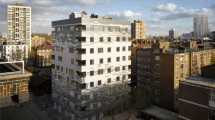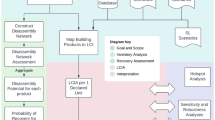Abstract
The catastrophic events of September 11, 2001, stand out as a major motivation for research on improving the understanding of structural behaviour in fire. These events included the first complete collapse of a tall steel framed structure solely due to fire. World Trade Center 7 (WTC7) was a 47-storey office building within the WTC complex that collapsed due to a fire initiated by debris from the collapse of WTC1. In the following years, detailed investigations were carried out by expert teams to pinpoint the cause of the progressive failure of WTC7. Each of the expert teams analysed the fire and structure and made varying conclusions with regards to the mechanisms responsible for initiating and propagating the collapse of the building. This paper revisits the collapse of WTC7 and its investigation, and then explores the hypothesis that a potential hydrocarbon fire may have compromised the large transfer structure within the mechanical space of the building. This is done via two OpenSees finite element models. The first model explores the thermomechanical response of the mechanical floors to a potential diesel fire, and the second investigates the response of the structure to a failure caused by that fire. The outcome of the analyses shows that it is feasible that a mechanical room fire could lead to a failure in the transfer structure, which would then result in the loss of support to at least two columns within the building core. The failure of these columns may unbrace the eastern-most core columns and precipitate in the failure of the structure as observed on 9/11.

















Similar content being viewed by others
References
NIST (2008) NIST NCSTAR 1A: final report on the collapse of the World Trade Center Building 7.
Lamont S, Lane B, Flint G, Usmani A (2006) Behavior of structures in fire and real design - a case study. J Fire Prot Eng 16:5–35
Dong YL, Zhu EC, Prasad K (2009) Thermal and structural response of two-storey two-bay composite steel frames under furnace loading. Fire Saf J 44:439–450
Nguyen TT, Tan KH, Burgess IW (2015) Behaviour of composite slab-beam systems at elevated temperatures: experimental and numerical investigation. Eng Struct 82:199–213
Yang ZN, Dong YL, Xu WJ (2013) Fire tests on two-way concrete slabs in a full-scale multi-storey steel-framed building. Fire Saf J 58:38–48
Khorasani NE, Gernay T, Fang C (2019) Parametric study for performance-based fire design of US prototype composite floor systems. J Struct Eng 145:1–15
Omer E, Izzuddin BA, Elghazouli AY (2010) Failure of unrestrained lightly reinforced concrete slabs under fire. Part I: analytical models. Eng Struct 32:2631–2646
Sadek F, El-Tawil S, Lew HS (2008) Robustness of composite floor systems with shear connections: modeling, simulation, and evaluation. J Struct Eng 134:1717–1725
Anvari AT, Bhardwaj S, Wazalwar P, Varma AH (2020) Structural fire engineering and design of filled composite plate shear walls (SpeedCore)
Weidlinger Associates Inc (2010) WTC 7 Collapse Analysis and Assessment Report
Ove Arup & Partners Consulting Engineers PC (2010) World Trade Center 7 Floor 12 Fire Effects Simulation
NIST (2005) NIST NCSTAR 1–1J: Documentation of the Fuel System for Emergency Power in World Trade Center 7
NIST (2005) NIST NCSTAR 1–1: design , construction , and maintenance of structural and life safety systems
NIST (2008) NIST NCSTAR 1–9: structural fire response and probable collapse sequence of the world trade centre building 7.
Frankel Steel Limited (1985) Erection drawings: 7 World Trade Center
Office of Irwin G. Cantor (1985) Structural design drawings: 7 World Trade Center
NIST (2005) NIST NCSTAR 1–5: reconstruction of the fires in the World Trade Center Towers
McAllister T, MacNeill R, Erbay O, Sarawit A, Zarghamee M, Kirkpatrick S et al (2012) Analysis of structural response of WTC 7 to fire and sequential failures leading to collapse. J Struct Eng (United States) 138:109–117
Guy Nordenson and Associates (2009) Photographic analysis: volume a photographic timeline. New York.
Mowrer F (2010) Expert report by Frederick Mowrer
National Fire Protection Association (2008) Fire protection handbook. 20th editi
Dassault Systèmes (2014) Abaqus analysis user’s guide
Lee J, Fenves GL (1998) Plastic-damage model for cyclic loading of concrete structures. J Eng Mech 124:892–900
Arup (2009) Master Assumptions List
Huang Z, Burgess IW, Plank RJ (1999) The influence of shear connectors on the behaviour of composite steel-framed buildings in fire. J Constr Steel Res 51:219–237
Guy Nordenson and Associates (2010) WTC7 Global Collapse Analysis Report and Summary of Findings.
Arup (2010) WTC -7 Structural Fire Analysis Report (Runs 1–4)
Del Savio AA, Nethercot DA, Vellasco PCGS, Andrade SAL, Martha LF (2009) Generalised component-based model for beam-to-column connections including axial versus moment interaction. J Constr Steel Res 65:1876–1895
BRE Centre for Fire Safety Engineering (2010) Analysis of the impact of a fire in the mechanical room (5th & 6th Floor) of the World Trade Center 7 Building
Thomas PH, Heselden AJM (1962) Fully developed fires in single compartments. Fire research note No 923, Fire Research Station, Borehamwood, UK
Jiang L (2015) Development of an integrated computational tool for modelling structural frames in fire considering local effects. The University of Edinburgh
Jiang L, Zhang Y, Zhang Z, Usmani A (2021) Thermal analysis of infrastructure in OpenSees for fire and its smart application interface towards natural fire modelling. Fire Technol 57:2955–2980
Orabi MA, Jiang L, Jin Q, Usmani A (2021) Modelling concrete slabs subjected to localised fire action with OpenSees. J Struct Fire Eng (in press)
Jiang J, Jiang L, Kotsovinos P, Zhang J, Usmani A, McKenna F et al (2015) OpenSees software architecture for the analysis of structures in fire. J Comput Civ Eng 29:04014030
Jiang L, Chen S, Usmani A (2018) Feasibility of dimensionally reduced heat transfer analysis for structural members subjected to localised fire. Adv Struct Eng 21:1708–1722
Jiang L, Orabi MA, Jiang J, Usmani A (2021) Modelling concrete slabs subjected to fires using nonlinear layered shell elements and concrete damage-plasticity material. Eng Struct 234:111977
Jiang L, Usmani A (2018) Towards scenario fires – modelling structural response to fire using an integrated computational tool. Adv Struct Eng 21:2056–2067
Jiang L, Dai X, Usmani A, Kamath P (2015) OpenSees-based integrated tool for modelling structures in fire. In: First International Conference on Structures Safe. Under Fire Blast, pp 461–8.
Orabi MA, Khan AA, Usmani A (2019) An overview of OpenSEES for fire. In: Proceedings of the 1st Eurasian conference on OpenSEES: OpenSEES days Eurasia pp 1–6.
Orabi MA, Khan AA, Jiang L, Yarlagadda T, Torero J, Usmani A (2022) Integrated nonlinear structural simulation of composite buildings in fire. Eng Struct 252:113593
CIMNE. GiD (2020).
Kartalis-Kaounis T, Papanikolaou VK (2017) GiD + OpenSees
Orabi MA (2021) GiD + OpenSees Thermo-mechanical Interface
Jiang J, Usmani A, Li GQ (2014) Modelling of steel-concrete composite structures in fire using OpenSees. Adv Struct Eng 17:249–264
Usmani A, Röben C, Al-Remal A (2009) A very simple method for assessing tall building safety in major fires. Steel Struct 9:17–28
Lange D, Röben C, Usmani A (2012) Tall building collapse mechanisms initiated by fire: mechanisms and design methodology. Eng Struct 36:90–103
Kotsovinos P, Usmani A (2013) The world trade center 9/11 disaster and progressive collapse of tall buildings. Fire Technol 49:741–765
Usmani AS, Chung YC, Torero JL (2003) How did the WTC towers collapse: a new theory. Fire Saf J 38:501–533
BSi (2004) EN 1992-1-2:2004:Eurocode 2: Design of concrete structures — Part 1–2: Structural fire design
BSi (2006) EN 1993–1–2:2005 Eurocode 3 — Design of Steel Structures Part 1–2: General rules — structural fire design. British Standards
Jiang Y (2012) Development and application of a thermal analysis framework in OpenSees for structures in fire. The University of Edinburgh
NIST (2005) NIST NCSTAR 1–6A: Passive Fire Protection. Washington, DC
Lu X, Xie L, Guan H, Huang Y, Lu X (2015) A shear wall element for nonlinear seismic analysis of super-tall buildings using OpenSees. Finite Elem Anal Des 98:14–25
Scott MH, Fenves GL (2010) Krylov subspace accelerated newton algorithm: Application to dynamic progressive collapse simulation of frames. J Struct Eng 136:473–480
NIST (2009) NIST Video: Why the Building (WTC7) Fell
Sun RR, Huang Z, Burgess IW (2010) A static/dynamic procedure for collapse analysis of structure in fire. In: Proc Fire Safety Engineering in the UK: The State of the Art pp 37–42.
Acknowledgements
The work described in this paper was supported by a grant from the Research Grants Council (RGC) of the Hong Kong Special Administrative Region, China, for the Project ‘OpenFIRE: An Open Computational Framework for Integrated Simulation of Structural Response to Fires’ (Project No. PolyU 15220618), and by the Hong Kong Polytechnic University start-up fund 'Computational modelling on modern buildings subjected to fires' (Project No. P0031564). The PhD studies of the second author are supported by the Hong Kong PhD Fellowship Scheme established and funded by the RGC.
Author information
Authors and Affiliations
Contributions
Mhd Anwar Orabi: Conceptualization, Investigation, Writing-original draft, Formal analysis. Liming Jiang: Supervision, Writing-review & editing, Funding acquisition. Asif Usmani: Conceptualization, Supervision, Formal analysis, Investigation, Resources. Jose Torero: Conceptualization, Supervision, Formal analysis, Investigation.
Corresponding authors
Ethics declarations
Conflict of interest
The authors declare that there is no conflict of interest.
Additional information
Publisher's Note
Springer Nature remains neutral with regard to jurisdictional claims in published maps and institutional affiliations.
Rights and permissions
About this article
Cite this article
Orabi, M.A., Jiang, L., Usmani, A. et al. The Collapse of World Trade Center 7: Revisited. Fire Technol (2022). https://doi.org/10.1007/s10694-022-01225-2
Received:
Accepted:
Published:
DOI: https://doi.org/10.1007/s10694-022-01225-2




